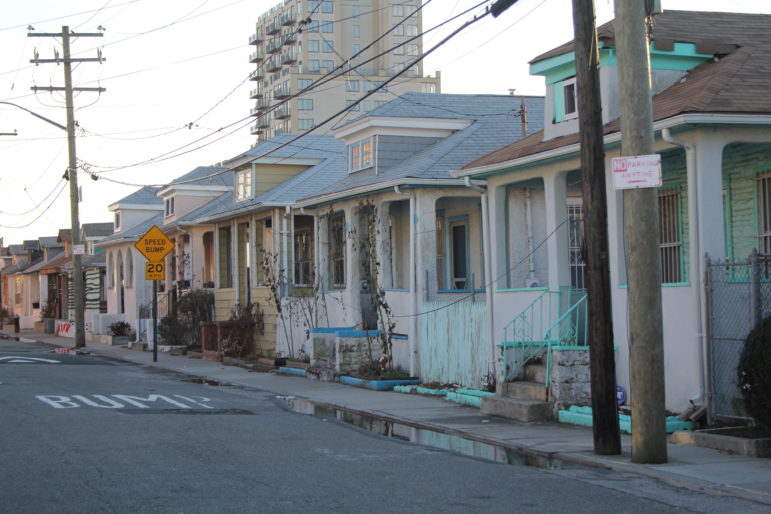
Peter Greenberg
Some residents are worried that increased residential density will strain resources on the peninsula.
Attendees at a hearing for the Far Rockaway rezoning proposal on Tuesday night made clear their unanimous support for commercial revitalization and new amenities, but expressed more hesitation about the housing component of the plan. Many had concerns about the impact of a large population increase on neighborhood infrastructure and residents also disagreed on the affordability levels for the proposed units.
Far Rockaway is one of the nine neighborhoods targeted for increased housing density as part of the mayor’s affordable housing plan. The Economic Development Corporation’s rezoning proposal is expected to introduce more than 3,000 new apartments and facilitate the creation of retail, community facility and open space.
The community’s letter of recommendations, mailed to Mayor de Blasio in February, did call for new, mixed-income housing, and residents at the hearing acknowledged that attracting people with disposable income would boost commercial activity. Yet some questioned whether so much housing would be necessary.
“They keep wanting to saturate the area, the whole of the peninsula with housing. How much housing can we take?” said Shermane Stewart-Lester, a homeowner in Edgemere, to City Limits after the hearing.
Several testifiers echoed the pleas of Allison Jeffrey, a resident who opposes the city’s plan to turn a vacant city site into eight units of income-restricted housing. Instead, she proposes, that lot could become a community gardening space or an urban farm to improve the neighborhood’s healthy food options.
Many expressed concern about the plan’s impact on parking, with residents complaining that a lack of spaces is already a deterrent to residents trying to run errands downtown. Several proposed the creation of a parking garage with spaces for emergency and police vehicles.
Testifiers also said the city should create recreational opportunities for the neighborhood’s youth, as well as new schools, and examine the impact on sewage infrastructure and traffic congestion. Community Board 14 District Manager Jonathan Gaska opposed the plan’s 15-stories buildings, saying they would be out of character and create shadows. And though EDC’s presentation noted the rezoning area is the only part of the peninsula not in a flood plain, that didn’t stop Sandy survivors in the room from worrying about storm safety with an increased population.
“Where do you go when there’s a storm and everybody says evacuate?” testified Phyllis Rudnick of the Bays Civic Association.
There were mixed sentiments on the issue of affordability for the new housing. Several members of the community board opposed building more affordable housing in a neighborhood already struggling with high unemployment and gang activity.
“We want to bring people who have jobs. We have a lot of people here who don’t have jobs,” said Gaska, presenting the board’s position that any income-restricted housing should cater to families making no less than $50,000, or about 60 percent AMI.
Yet it is possible that the board, which critics say is dominated by residents from the wealthier part of the Rockaways, did not reflect the sentiments of low and middle-income Far Rockaway residents. Some hearing attendees told City Limits that they feared the revitalization would displace members of the existing community, especially because Sandy had a negative impact on local incomes.
“You’re revitalizing but what happens to the seniors?” said a 76-year-old resident who identified herself as Mrs. Warren. She said, however, that she didn’t want more “low-income housing” in the neighborhood. “I’m $5 dollars over to get into the low-income housing, and I can’t afford the middle-income housing…Your ‘revitalizing’ is going to put me out on the street.” (Mrs. Warren makes $28,000 a year and would not qualify for some Section 8 voucher programs, but would qualify for housing in the 40 percent AMI range.)
Councilman Donovan Richards has said he is committed to ensuring at least a portion of units are deeply affordable. He called on the city to use subsidies to create apartments for families making 30 percent AMI or $24,480 for a family of three, and requested the city explore establishing a community land trust and consider purchasing neglected, private properties to ensure some of that affordability is permanent.
In his testimony he also called for a new performance-art space, increased investment in storefront enhancements, improved ferry service, expansion of the Far Rockaway police precinct, storm resiliency measures, healthy food options, new schools and health centers, more stringent local hiring agreements for projects receiving city subsidy, that the city strive to award 30 percent of contracts to minority- and women-owned businesses, adequate parking and potentially even a new CUNY campus.
City Limits’ coverage of housing and development is supported by the New York Community Trust and the Charles H. Revson Foundation









One thought on “Divisions Emerge Over Rockaways Rezoning Proposal”
I think this revitalization plan is good for the entire peninsula. However, it must include some market rate in come to attract and sustain the local economy. Simply building housing is not the only answer. Residents want fresh food, restaurants, entertainment venues and everything that makes a community what it should be. We certainly need a heliport to take acute cases of trauma off the peninsula until we can get a trauma center.